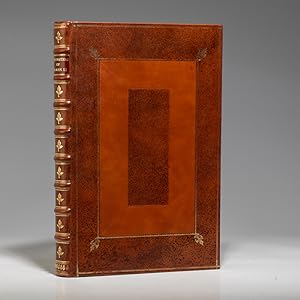james sandford francis (1 risultati)
Tipo di articolo
- Tutti gli articoli
- Libri (1)
- Riviste e Giornali
- Fumetti
- Spartiti
- Arte, Stampe e Poster
- Fotografie
- Mappe
-
Manoscritti e
Collezionismo cartaceo
Condizioni
- Tutte
- Nuovi
- Antichi o usati
Legatura
- Tutte
- Rilegato
- Brossura
Ulteriori caratteristiche
- Prima edizione
- Copia autografata
- Sovraccoperta
- Con foto
- No print on demand
Paese del venditore
Valutazione venditore
-
History of the Coronation
Data di pubblicazione: 1687
Da: Bauman Rare Books, Philadelphia, PA, U.S.A.
Prima edizione
First Edition. "(JAMES II) SANDFORD, Francis. The History of the Coronation of the Most High, Most Mighty, and Most Excellent Monarch, James II And of His Royal Consort Queen Mary The Whole Work Illustrated with Sculptures. (London): Thomas Newcomb, 1687. Tall folio (11-1/2 by 17 inches), period-style full paneled calf gilt, raised bands, burgundy morocco spine label, all edges gilt. $13,500.Rare first edition of this History of the Coronation of James II "His Robes of Purple Velvet, Furred with Ermine, and the Crown of State on His Head" a scarce fête book richly illustrated with 30 copper-engraved folio plates (29 double-page), including the rarely found Fireworks plate. From the library of Baronet Sir John Hynde Cotton, "politician and Jacobite sympathizer" (ODNB), with his armorial bookplate affixed to the verso of the title page.King James II's coronation on April 23, 1686 established a tradition "long followed by his successors" (Macaulay, History, 440). At age 12 James barely escaped with his life when forced to flee England, and waited 40 years to inherit the crown from his brother Charles II. Distinguishing himself as an officer abroad, then in Britain upon Charles' restoration to the throne, James converted to Catholicism and faced new exile amidst fierce anti-Catholic agitation. Nevertheless when Charles II died in February 1685, James' accession was "unexpectedly peaceful considering the attempts made to exclude him because he was an avowed Catholic" (Fraser, Lives, 244-5). At his coronation many stood awestruck at its lavish pageantry in which "Westminster Abbey and the Hall were splendidly decorated The service in the church was followed by a stately banquet in the hall [and] the banquet by brilliant fireworks" (Macaulay, 440). This exceptional folio volume was produced by Herald Francis Sandford but not published until two years after the coronation, and only one year before James was forced from the throne in the "Glorious Revolution." Given James' rapid departure, Sanford's History barely met its expenses and he died in debtor's prison. The 30 superb copper-engraved plates (29 double-page) by eminent English artists of the time include depictions of the royal regalia, a wonderful series of images of the procession to the Abbey with many individualized portraits, representations of the coronation ceremony and a view of the banquet, with a full listing of the 1445 dishes served. With engraved historiated initials, in-text illustrations, head- and tailpieces; vignette title page in red and black. This copy with the Imprimatur leaf and Fireworks plate, both often lacking. Wing S652 (with Newcomb's name printed in red, as here the issue Wing lists first). Engraved armorial bookplate of Sir John Hynde Cotton, Third Baronet (baptized 1686, the year before this book's publication; died 1752), to verso of title page; also with the engraved armorial bookplate of a descendant to front pastedown. "By 1733 he was being described as one of 'the leaders of the Tories', even as 'the very head of the violent (some will say the Jacobite) party.' When Beaufort revived the Loyal Brotherhood, Cotton was one of its most active members. But even at this point there is little to link him directly with the Pretender. It was only in the early 1740s that he took part in Jacobite intrigues and corresponded with the court at St. Germain Cotton did not heed the Jacobites' call during the rising of 1745; in fact, he kept his place in government and ostentatiously proclaimed his loyalty to the Hanoverian dynasty when the rebellion was over. But he was still dismissed from office a year later and returned to opposition" (ODNB).Occasional spotting, chiefly marginal or to plate versos; leaf Gg with marginal repair, not affecting text. A couple of engravings with short splits along the folds, impressions generally quite clear. Binding handsome and fine. A lovely copy with an intriguing Jacobite provenance.".


